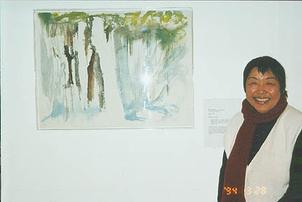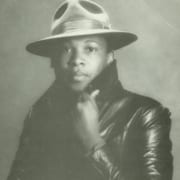Flo Oy Wong on Bernice Bing
WOMEN’S CAUCUS FOR ART 1996
Honor Award Ceremony
an excerpt from the presentation ceremony
By Flo Wong
There is nothing more challenging to us as human beings than to embark on the path of self-enlightenment. Throughout her life, tonight’s honoree has done this admirably. It is with great honor that I introduce Bernice Lee Bing–artist and activist–who has courageously searched for self-enlightenment through a life of creativity and community commitment.
To highlight Bing’s life and art, I quote from the Tao Te Ching by Lao Tsu who taught about life and spirituality in ancient China 2,500 years ago. For me, Bing’s life and art exemplify the Tao which means THE WAY. Simply stated, it addresses a possible inner greatness and an equally possible inner failure.
In 1989, I met Bing in Oakland, California at an Asian American Women Artists Association meeting. When I first saw Bing’s paintings. I was overwhelmed with her masterful strokes, rich colors, glowing light and fluid, organic shapes. Her art made me hear cymbals of silence; I was immediately whisked into her artistic milieu.
At the time. I was project director for an exhibition entitled Completing the Circle: Six Artists featuring Northern California-based American artists of Chinese descent. This was intended to travel to China: its goal, to introduce contemporary Chinese American artists to the ancestral homeland.
Bing was accepted into the exhibition for her powerful abstract paintings expressing visual intersections of East and West. Raging Wind, an oil painting created in 1986, reveals what art writer Valerie Soe calls Bing’s intuitive process of the subconscious mind. Soe notes that Bing’s “Sweeping lines and splashes of paint on canvas evocatively spoke of Abstract Expressionism, Chinese calligraphy and painting.” Her strong and personal art revealed an aesthetic search for light within the dark metaphor of the Tao’s teaching.
Bing was born in San Francisco’s Chinatown in 1936, when immigration from China was still restricted by the 1882 Chinese Exclusion Law. Her mother had married when she was eighteen. Although she was a wife and mother, she wanted a glamorous life beyond domesticity and worked at Shanghai Low, a popular Chinatown night club when Bing was a child.
When Bing was six years old her American-born mother died of a heart ailment. After her mother’s death, Bing lived in Caucasian foster homes, occasionally staying with her grandmother. Bing’s movement in two disparate worlds–Chinese and American–had begun.
Bing’s bound-feet grandmother, traditional, subservient and angry, was abusive to Bing. And Bing was rebellious. She had difficulty assimilating at a middle class white school and did not do well academically. But drew to fill her time.
When Bing was seven, her art caught her grandmother’s attention and she frequently praised Bing’s emerging talent. Thus began Bing’s realization that art would be the means to understand her two cultures. Bing subsequently found her voice in life–and it has stayed with her ever since.
Through art, Bing dealt with the remoteness of her family and life set in a transplanted culture and the non-Asian world she encountered.
In 1958, she attended California College of Arts and Crafts in Oakland on a scholarship, studying with Nathan Oliveira, Saburo Hasegawa and Richard Diebenkorn. Under the tutelage of Hasegawa she blossomed, switching her major from advertising to painting. Hasegawa’s use of Zen meditation in his dreamy-abstract and calligraphic art captured her attention.
Bing considering what it meant to be an Asian woman in America, pursued the poetry of Lao Tsu and other Eastern philosophers to learn more about her self, family and history. To this day, the spirituality of Eastern metaphysical thought informs her work.
After a semester at California College of Arts and Crafts, Bing transferred to the San Francisco Art Institute where she studied painting with Elmer Bischoff and Frank Lobdell. It was a time of the avant-garde. Bing’s artistic mentors were varied. Among them were de Kooning in art, Stein in poetry, Camus in literature, Beckett in theater and Fellini in art films.
In 1961, Bing graduated from the San Francisco Art Institute with a Masters in Fine Arts degree. She painted Blue Light in the same year, with a red ideogram, which in Chinese means people or humanity, in the bottom left corner. There is also a suggested shape of a heart. Both symbols–humanity and heart–reflect Bing. They direct me to chapter ten of the Tao which reads:
Understanding and Being open to all things,
Are you able to do nothing?
Bing did something.
Following her graduation, Bing was active in the Bay Area art scene. She had befriended Joan Brown and accompanied Brown in 1960 to New York for Brown’s first one-person exhibition. In New York, Bing met Marcel Duchamp.
In California, exhibiting locally in San Francisco and Berkeley, she received critical acclaim. Alfred Frankenstein, critic for the San Francisco Chronicle, noted Bing’s remarkable gift for the fluid line. Bing’s remarkable fluid lines are still strong after thirty years of painting.
In 1961, Bing worked as a caretaker at Mayacamas Vineyard in Napa Valley, where she experienced first-hand the power of nature. For Bing, nature was tactile and captivatingly spiritual. As a resident artist at Esalen in 1967, she was among the first to study New Age psychology and philosophy with Abraham H. Maslow, Joseph Campbell, Alan Watts, Ronald D. Laing and Fritz Perls.
It was an eye opening time for Bing. At Esalen, she concentrated on learning about her self through psychological and philosophical studies.
It was trail-blazing for Bing to depart from her traditional culture which emphasized family over a sense of self.
In 1968, Bing served on a National Endowment for the Arts panel for the Arts expansion program. In the early 1970s , she organized art events and programs in San Francisco. Among her achievements was establishing the first Asian American Art Festival at the SF Civic Center.
During a violent phase in Chinatown when killings were rampant. Bing established an art workshop with the Baby Wah Chings, a Chinatown gang. That program gave eleven to thirteen year olds a place to channel their energies. For those efforts, Bing won recognition. In 1983, she received the Distinguished Alumni Award from the San Francisco Art Institute. In 1984, Bing was awarded the SF Art Commission Award for Distinguished Work and Achievement in Community Arts. From 1980-1984, she directed and established innovative programs at the South of Market Cultural Center.
Her creative energy depleted, she renewed her life with a stay in China–the home of her ancestors–as well as Korea and Japan. In China she studied calligraphy and painting at the Zhejiang Academy in Haungzhou. And she lectured on Abstract Expressionism, helping Chinese art students understand the world of art.
Refueled and rested, she returned to the United States and settled in rural Philo in Northern California to begin art-making anew. Vital Energy, a 1986 oil painting, talks about the lifeblood of creating after an absence. In 1990, Bing received the Asian Heritage Council Art Award in recognition of her talent and her pioneering efforts to serve the art and Chinese American cultural communities in San Francisco.
Bing’s paintings from the late 1980s and early 1990s illustrate the unspoken heritage of her training grounded in Abstract Expressionism. They also portray Bing’s painterly calligraphic synthesis of the old world of China. The impasto of the paint comes from the buildup of calligraphic lines. Lotus Root , 1992, oil on canvas, refers to opening up with her Quantum Series Bing represents realms of possibility. She is still exploring the mystery of how small elements become a part of the whole.
In her life, Bing has discovered that art provided unity between her dual cultures. For her, virtue and perseverance are abundant.
It is with great honor that I present the distinguished Bernice Lee Bing. Through dedication to art and activism, Bing has walked the path of self enlightenment.
“Knowing the self is enlightenment.”
Tao Te Ching, chapter thirty-three
BERNICE LEE BING
By Flo Oy Wong
When Bernice Lee Bing entered the San Francisco Bay Area art scene in the 1960s she was a pioneer from a predominantly conservative ethnic culture. She searched for visual articulation as a “minority in a majority art world.”1 Her paintings engaged viewers in an esoteric world, affirming the transformation of formalist considerations to statements of poetical abstraction. Before Bing, a few Asian American West Coast artists focused on Zen (Saburo Hasegawa, Paul Horiuchi) and worked toward abstraction in their painting (Leo Walledor, Carlos Villa). Among them was Bing’s mentor, Hasegawa.
Bing emerged during an era when Asian American artists were considered successful; 2 studying with Richard Diebenkorn and Hasegawa at the California College of Arts and Crafts (CCAC) in Oakland, California. She responded strongly to Hasegawa’s “dreamy abstract” 3 calligraphy, which was Zen-inspired. That inspiration seeded her interest in Asian poetry, which later culminated in abstract paintings. Bing received critical attention for these paintings at her first one-person exhibition in San Francisco in 1961.
At the age of seven, Bing received recognition from her grandmother for her drawings. That acknowledgment initiated Bing’s search for the creative process that would define her life. While Bing harbored other childhood dreams, she ultimately chose the path of the painter. Upon graduation from the San Francisco Art Institute with a BFA and an MFA, Bing continued to experiment with abstract painting and the incorporation of Zen and calligraphy within her oeuvre, immediately attracting critical attention from Artforum in 1963. She forged ahead to study Eastern and Western psychological and philosophical thought in order to grow through contemplative study. At Mayacamas Vineyards, drawn to the magnificence of nature, Bing voraciously studied the work of C. G. Jung, embracing his concept of the spiritual aspects of visual work. She subsequently painted a Mayacamas series for which she received another Artforum review in 1964. As an artist in t he first residential program at Esalen (1967-68), a center for parapsychology and religious philosophy, Bing absorbed herself in exploration levels of the unconscious mind. She reached for the essence of self through the deconstruction of superficialities. 4 Psychological dialogues entered into her artistic consciousness, motivating Bing to paint a work entitled Big Sur , which symbolized breaking through to the core of her inner self.
These experiences at Esalen took Bing further away from her traditional Chinese environment, where family and cultural dynamics discouraged explorations of self, toward Western culture’s emphasis on the individual. Bing transformed this cultural intersection in her paintings to create synergistic threads of fluidity/rigidity and dark/light.
In the 1970s, Bing returned to San Francisco to organize within the community. She established the first Asian American art festival and created a workshop to give children in Chinatown (her birthplace) art-making skills during a particularly violent time in the community. Later, in the 1980s, Bing became the director of the South of market Cultural Center (SOMAR) and executive director of Friends of Support Services for the Arts. This five-year period of community activism left bing with little time to paint Weary, in 1984 Bing took a sojourn to her ancestral homeland of China, studying calligraphy and painting at the Zhejiang Academy in Haugzhou. The studies refueled her creativity.
At home in rural Philo, California (Mendocino County) in 1985, Bing practiced calligraphy to create intensity of light in landscape. This led to the 1991-92 Quantum series, a renaissance in her painting career. An exhibition renaissance occurred as well. Bing was invited in the late 1980s by the Asia Heritage Council, 5in collaboration with the Triton Museum of Art, to exhibit once again in t he Northern California region. In 1995, Bing’s work was included in With New Eyes: Towards An Asian American Art History in the West, a significant historical survey of Asian Pacific American artists from 1860 to 1965.
Throughout her life, Bernice Lee Bing has always expanded her creative dialogue. Following a path of unknowing, she explored creatively through painting. She philosophically integrated the Chinese and American segments of her character, advocating spirituality and a sense of giving. Through her compelling ability to paint, her strength of character, her ability to visualize a dual heritage, and her influence on younger Asian American women artists, Berice Lee Bing has claimed her place in contemporary American art history.
Notes
1.Mayumi Tsutakawa, “The Asian American West Coast, 1945 to 1965; A Renaissance in Painting, Sculpture, Ceramics, Textiles and Photography,” in With New Eyes, Exh.cat., September 1995.
2. Idid.
3. Moira Roth, “A Narrative Chronology,” in Bernice Bing, exh. cat., Visibility Press, September 1991.
4. Ibid.
5. The Asian Heritage Council, a northern-California-based arts agency, organized Completing the Circle: Six Artists in collaboration with the Triton Museum of Art in Santa Clara, California. The exhibition originally was scheduled to show in Shanghai, People’s Republic of China, but was canceled because of the 1989 Tian’anmen Massacre. It was subsequently shown in Northern California in 1990 and 1992.
Women’s Caucus for Art
1996 Honor Award to Bernice Bing
Bernice Bing: an essay
by Flo Oy Wong



